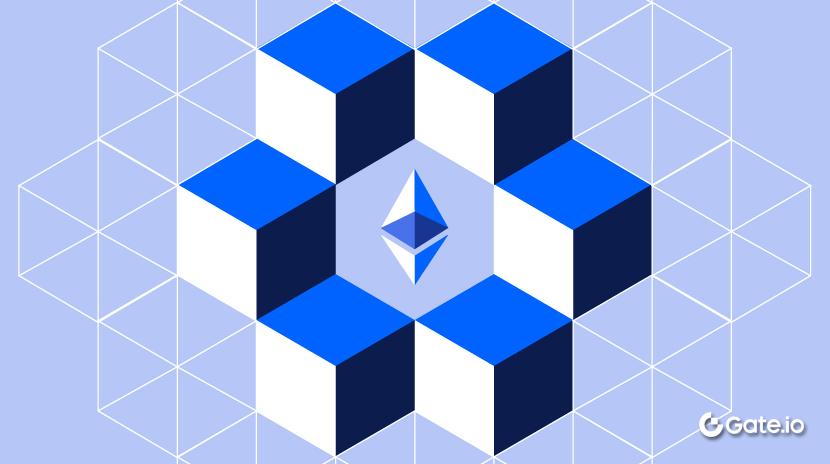Recherche Gate : le risque de décollage de sUSD s'intensifie, Berachain entre dans le top 6 du TVL, Raydium lance LaunchLab
Résumé
- Après un bref rebond, le BTC et l'ETH sont entrés dans une phase de consolidation, maintenant une fourchette de négociation latérale.
- Soneium, en collaboration avec EigenLayer, a lancé un 10-second Couche de finalité rapide, marquant une percée dans les performances de la couche 2.
- Le gouvernement de la ville de Panama a annoncé son soutien aux paiements cryptographiques, faisant avancer les efforts de conformité cryptographique.
- Le risque de déconnexion de sUSD a augmenté, provoquant la panique sur le marché.
- KiloEx a perdu 7 millions de dollars dans une attaque de prêt flash, entraînant la suspension du service et une proposition d'accord de chapeau blanc à l'attaquant.
- Raydium a lancé LaunchLab, une nouvelle plateforme d'émission de jetons visant à améliorer l'infrastructure de Solana et les mécanismes d'incitation des créateurs.
- En mars, les mineurs ont vendu plus de 40% de leur production de BTC, poussés par la hausse des coûts opérationnels et l'incertitude macroéconomique.
Analyse du marché
Examen et perspectives
- BTCCette semaine, le BTC a continué sa tendance de récupération qui a commencé début avril, se négociant actuellement à 84 152 $. D'un point de vue à long terme, le BTC a confirmé à plusieurs reprises un support autour du niveau de 76 000 $ depuis son rebond plus tôt ce mois-ci et revient progressivement vers les zones clés des moyennes mobiles, suggérant une stabilisation potentielle de la tendance haussière plus large. Le prix se négocie maintenant au-dessus de la MA30 (84 458 $), testant actuellement ce niveau par le haut. Une rupture avec un volume accru confirmerait davantage la continuation du rebond. La structure globale reste dans un canal de consolidation, avec un mouvement latéral à court terme aidant à construire un élan pour la prochaine phase de hausse. Bien que les lignes du MACD aient légèrement baissé, elles restent au-dessus de la ligne zéro, et l'histogramme n'a pas encore clairement basculé en négatif, ce qui indique une pression à la baisse limitée et une perspective à moyen et long terme toujours haussière.

- ETH L’ETH se négocie actuellement à 1 582 $ après une correction importante au début du mois d’avril. Dans une perspective à long terme, il a trouvé un certain support autour de 1 550 $, mais une structure de rebond claire ne s’est pas encore formée, les haussiers et les baissiers étant actuellement en équilibre. Techniquement, l’ETH continue de se négocier en dessous de la MA30 (1 612 $), et les MA à court terme (MA5 à 1 585 $ et MA10 à 1 589 $) sont étroitement liées, reflétant l’indécision et la faible dynamique de rebond. À moins que l’ETH ne puisse dépasser la résistance MA30, le marché pourrait rester dans un état de consolidation faible. Les lignes MACD se déplacent latéralement près de l’axe zéro, avec une alternance de barres rouges et vertes, ce qui indique une réduction de la dynamique du marché et l’absence d’un support de volume fort dans les deux sens. [2]

- Altcoins— Au cours des 7 derniers jours, le marché des altcoins a connu un large rebond, les gains dépassant ceux de la semaine précédente. Les secteurs les plus performants étaient les plates-formes de lancement d'agents d'IA, les cryptomonnaies de mèmes d'IA et le LSDFi, avec des augmentations de capitalisation boursière respectives d'environ 188.3 %, 40.8 % et 38.2 %. [3]
- Futures— Au 17 avril 2025, à 08h00 (UTC+8), l'intérêt ouvert total des options BTC s'élevait à 244 millions de dollars, en baisse marquée par rapport à 2,911 milliards de dollars la semaine dernière. Au cours de cette période, le BTC a chuté à un minimum de 83,200 dollars avant de reprendre sa tendance à la hausse. [4]
- Données Macro— Le 17 avril, les indices boursiers américains ont clôturé en baisse : le Dow Jones a chuté de 1,73 %, le S&P 500 a baissé de 2,24 % et le Nasdaq a reculé de 3,07 %, tombant même de plus de 4 % en intraday. Les actions technologiques ont sous-performé, l'indice des grandes entreprises technologiques américaines a reculé de 4,07 %. Le sentiment de prudence s'est intensifié, poussant l'or au-dessus de 3 330 $ l'once. Le président de la Fed, Jerome Powell, a déclaré que les décisions sur les taux seraient basées sur les données économiques à venir et a attribué la récente volatilité du marché à la politique tarifaire de Trump, niant explicitement un "filet de la Fed". Son ton belliqueux a accéléré la vente d'actions. [5]
- StablecoinsLe plafond total du marché des stablecoins a augmenté de 0,23% cette semaine pour atteindre 234,1 milliards de dollars, indiquant une petite afflux de capitaux hors marché.
- Frais de gazAu cours des 7 derniers jours, les frais moyens de gaz d'Ethereum ont augmenté à 0,375 Gwei, avec une légère baisse de l'activité globale du réseau. [7]
Concepts Tendances
Cette semaine, le Bitcoin a été échangé entre 82 500 $ et 84 000 $, tandis que la plupart des secteurs des altcoins ont enregistré des gains. Selon les données de CoinGecko, les secteurs les plus performants étaient les AI Agent Launchpads, les AI Meme coins et le LSDFi, avec des augmentations respectives de la capitalisation boursière sur 7 jours d'environ 188,3 %, 40,8 % et 38,2 %. [8]
Lancement de l'agent AI LaunchpadCe secteur fait référence aux écosystèmes de plateformes décentralisées axées sur la construction, le déploiement et la monétisation d'agents AI autonomes. En offrant des outils de développement, des mécanismes de tokenisation et des cadres de gouvernance communautaire, les utilisateurs peuvent facilement créer des agents AI avec des capacités cognitives, de prise de décision et d'exécution, et les intégrer dans des applications Web3 telles que DeFi, les médias sociaux et les jeux.
Le secteur du lancement de l'agent d'IA a bondi de 188,3 % au cours des 7 derniers jours, atteignant une capitalisation boursière de 2,041 milliards de dollars et un volume de trading sur 24 heures de 318 millions de dollars. Notamment, MINDS, un jeton de ce secteur, a augmenté de 13 674,6 % au cours de la dernière semaine.
AI MemeCe secteur tourne autour des actifs cryptographiques qui fusionnent les narrations de l'intelligence artificielle (IA) avec la culture des mèmes. Il met l'accent sur les lancements de jetons créatifs, l'excitation communautaire et les transactions spéculatives autour du thème de « IA + mèmes », visant à attirer l'attention virale et le consensus communautaire à faible coût.
Le secteur des mèmes AI a augmenté de 40,8 % au cours des 7 derniers jours, avec une capitalisation boursière de 2,232 milliards de dollars et un volume de transactions sur 24 heures de 885 millions de dollars. Dans cette catégorie, AIDOGE a progressé de 273,9 %, AVA a augmenté de 73,9 % et AKI a grimpé de 63,6 % au cours de la semaine dernière. [10]
LSDFiCe secteur fait référence aux écosystèmes de protocoles DeFi centrés sur les actifs de jalonnement liquide, permettant le prêt, le trading et l'agrégation de rendement autour des stTokens pour améliorer l'efficacité du capital des LSD (Dérivés de Jalonnement Liquide).
Le secteur LSDFi a enregistré une augmentation de 38,2% de la capitalisation boursière cette semaine, atteignant environ 1,62 milliard de dollars, avec un volume d'échanges sur 24 heures de 476 millions de dollars. Parmi les jetons de ce secteur, RAFT a augmenté de 38,1% au cours des 7 derniers jours. [11]
Meilleurs Performants
Selon les données de CoinGecko, les jetons les plus performants au cours des 7 derniers jours sont les suivants: [12]

CRV (Curve DAO)— Gain de 7 jours d'environ 21,2 %, avec une capitalisation boursière circulante de 833 millions de dollars.
Curve Finance est une bourse décentralisée axée sur des swaps efficaces entre des stablecoins et des actifs adossés. Construite sur Ethereum et utilisant un modèle de Market Maker Automatique (AMM), elle optimise les échanges à faible glissement entre des actifs similaires. La plateforme attire la liquidité grâce à des conceptions de pool multi-actifs et à des mécanismes d'incitation, permettant aux utilisateurs de gagner des frais de transaction et des jetons de gouvernance CRV en fournissant de la liquidité. En tant qu'infrastructure DeFi centrale pour le trading de stablecoins et l'agrégation de rendement, Curve a été largement intégrée dans les principaux écosystèmes de protocoles.
Récemment, avec l'expansion continue des stablecoins tels que USDC, DAI et USDT, le volume des échanges sur Curve a considérablement augmenté, ce qui a stimulé les revenus du protocole. À ce jour, Curve a distribué plus de 155 millions de dollars de revenus réels (hors incitations supplémentaires à la gouvernance) aux détenteurs de CRV, créant un cycle positif entre la demande croissante de stablecoins et les récompenses des détenteurs de jetons. Ce changement fondamental a conduit le marché à réévaluer la valeur du CRV, devenant l'un des principaux moteurs de sa récente flambée des prix. [13]
KAS (Kaspa) - Gain de 7 jours d'environ 12,9 %, avec une capitalisation boursière en circulation de 1,957 milliard de dollars.
Kaspa (KAS) est une blockchain de couche 1 basée sur la preuve de travail et le protocole GHOSTDAG, conçue pour des confirmations plus rapides et une plus grande évolutivité. Contrairement aux blockchains traditionnelles, Kaspa utilise une structure de graphe acyclique dirigé (DAG) qui permet la création et le traitement de plusieurs blocs en parallèle, ce qui augmente considérablement la vitesse de génération de blocs et le débit du réseau.
Une importante mise à niveau de fork dur, Crescendo v1.0.0, est prévue pour début mai. Elle marque l'achèvement de la feuille de route de développement de KIP1 à KIP15, augmentant la vitesse de production de blocs du réseau de 1 BPS (bloc par seconde) à 10 BPS. Cela améliorera considérablement la capacité de transaction et l'expérience utilisateur en raccourcissant les intervalles de blocs. La mise à niveau renforce l'utilité et la scalabilité du réseau, renforçant la confiance parmi les mineurs et les utilisateurs. Actuellement, plus de 45% des nœuds ont été mis à niveau, et le support de hashrate se situe à 37,45%. À l'approche de la mise à niveau, de fortes attentes du marché ont entraîné des gains de prix KAS.
SOL (Solana)— Gain de 7 jours d'environ 10,3 %, avec une capitalisation boursière circulante de 67,7 milliards de dollars.
Solana (SOL) est une plateforme blockchain de troisième génération à haute performance conçue pour fournir une infrastructure rapide, sécurisée et évolutive pour les applications décentralisées (DApps) et les contrats intelligents. Ses principales caractéristiques incluent un débit élevé, une faible latence et des frais de transaction réduits, ce qui en fait une solution idéale pour les cas d'utilisation dans la finance, les jeux et les NFT. Solana exploite une combinaison de Preuve d'Histoire (PoH) et de Preuve d'Enjeu (PoS) pour améliorer les performances du réseau.
Récemment, Solana a réussi à mettre en œuvre la mise à niveau SIMD-0207, augmentant la limite de taille des blocs de 4 %, améliorant le débit et la scalabilité. De plus, un gestionnaire d'actifs canadien a lancé quatre ETF spot Solana sur la Bourse de Toronto (TSX), marquant les premiers produits négociés en bourse (ETP) Solana en Amérique du Nord à offrir une fonctionnalité de mise en jeu. Cette étape offre aux investisseurs un accès plus facile à SOL et a considérablement stimulé l'attention du marché, contribuant à la dynamique haussière du jeton.
Mises en lumière hebdomadaires
Examen des sujets chauds
Soneium, soutenu par Sony, s'associe à EigenLayer pour réduire le temps de finalité de 98 %, établissant ainsi un nouveau benchmark de performance L2
Soneium, un réseau blockchain soutenu par Sony, a annoncé un partenariat stratégique avec AltLayer et EigenLayer pour lancer un Couche de finalité rapideCela réduit le temps de finalité des transactions de 15 minutes à moins de 10 secondes, une amélioration de plus de 98 %. Cette percée améliore considérablement l'expérience utilisateur et permet une prise en charge haute performance des cas d'utilisation de blockchain grand public tels que les paiements, les jeux et le traitement des données en temps réel.
Dans le domaine de la blockchain, le temps de finalité des transactions détermine quand un réseau considère une transaction comme définitivement valide, c'est un paramètre crucial pour évaluer l'utilisabilité et la sécurité. Auparavant, Soneium utilisait l'architecture OP Stack d'Optimism, qui était limitée par des mécanismes de séquenceur et de période de défi, nécessitant environ 15 minutes pour une confirmation finale. Maintenant, en incorporant le réseau de validateurs décentralisés d'EigenLayer et en intégrant la couche d'exécution élastique d'AltLayer, Soneium a construit une infrastructure L2 qui équilibre le débit et la sécurité, établissant ainsi une base pour l'optimisation des performances futures et l'expansion de l'écosystème.
Comparé à d'autres principaux L2 comme Arbitrum et Optimism, le Couche de finalité rapideoffre un meilleur équilibre entre vitesse et sécurité. Cela le positionne bien pour attirer des applications sensibles à la latence, y compris des stratégies DeFi à haute fréquence, des jeux Web3 et des systèmes de paiement, tout en renforçant la fidélité de l'écosystème et l'engagement des développeurs. [17]
Panama City prend la tête en acceptant les paiements en cryptomonnaie, ouvrant un nouveau chapitre dans les cryptomonnaies
La capitale du Panama a franchi une étape cruciale vers l'intégration des actifs numériques dans les services publics. Le 15 avril, le maire de Panama, Mayer Mizrachi, a annoncé que le conseil municipal avait approuvé à l'unanimité une nouvelle politique permettant aux résidents de payer les impôts et les frais de services municipaux en cryptomonnaie. Cela fait de Panama City le premier gouvernement local du pays à adopter officiellement la cryptomonnaie pour les paiements publics.
La ville s'associera à une banque autorisée pour fournir une conversion de crypto en USD en temps réel, ce qui contribuera à atténuer la volatilité des prix et à maintenir la stabilité financière.
Ce mécanisme de paiement innovant marque non seulement une étape significative dans la numérisation des services municipaux, mais sert également de composante stratégique de la vision du Panama de devenir un "hub crypto." Au niveau national, le Panama développe également un système d'enregistrement pour les Prestataires de Services d'Actifs Virtuels (PSAV) et un cadre réglementaire de lutte contre le blanchiment d'argent (LBA), établissant ainsi les bases de la conformité pour la finance blockchain et les applications Web3.
La désynchronisation du sUSD s'intensifie, suscitant des inquiétudes sur le marché
Depuis le 10 avril 2025, le stablecoin sUSD au sein de l’écosystème Synthetix a connu une forte déchéance, se négociant actuellement à 0,8107 $, en baisse de 5,8 % aujourd’hui, avec une capitalisation boursière tombant à 25,76 millions de dollars. Le depeg est principalement lié à une mise à niveau continue du protocole, dans laquelle l’ancien système de gestion de la dette est remplacé par le nouveau mécanisme « 420 Pool », perturbant temporairement la stabilisation des prix basée sur le marché. Le fondateur de Synthetix, Kain Warwick, a souligné qu’il ne s’agissait pas d’une crise systémique, mais plutôt d’un problème de transition à court terme.
La stabilité de sUSD repose depuis longtemps sur une forte garantie du token SNX et un modèle d'ajustement dynamique de la dette. Sous le nouveau système, le ratio de garantie a été réduit à 200 % et le protocole prévoit de pardonner 62 millions de dollars de dette héritée au cours des 12 prochains mois pour améliorer l'efficacité du capital et la sécurité systémique. Cependant, pendant cette phase de transition, la confiance du marché envers sUSD a été ébranlée, entraînant une volatilité des prix accrue. L'équipe de Synthetix a mis en place plusieurs contre-mesures, notamment en renforçant les incitations pour les pools de liquidité Curve, en prolongeant le programme de dépôt Infinex et en jetant les bases de mécanismes de soutien des prix à long terme pour sUSD.
Cet événement de déconnexion a mis la confiance des investisseurs dans les stablecoins sous pression. Bien que la réponse de l'équipe puisse aider à stabiliser le sUSD au fil du temps, le jeton continue de se négocier de 5 à 10% en dessous de sa parité à court terme. À mesure que le nouveau système mûrit, le sUSD peut regagner en stabilité, mais l'incident a semé le doute parmi les détenteurs, soulignant que la «stabilité» d'un stablecoin dépend en fin de compte à la fois d'une conception solide et de la confiance du marché.
Incidents de sécurité
L'attaque de piratage de KiloEx se traduit par une perte de 7 millions de dollars
La plateforme de trading perpétuel décentralisée KiloEx a été piratée cette semaine, avec des pertes totales s'élevant à environ 7 millions de dollars. L'incident a affecté plusieurs blockchains, y compris Base, BNB Chain et Taiko. L'attaquant a exploité des vulnérabilités d'oracle et a utilisé des prêts flash pour manipuler les prix des actifs, puis a canalysé les fonds volés à travers Tornado Cash. La plus grande transaction unique a rapporté 3,12 millions de dollars.
Le 14 avril, KiloEx a annoncé d'urgence la suspension des services et a publié l'adresse du portefeuille de l'attaquant, appelant la communauté à aider à suivre les fonds. L'équipe a depuis lancé une enquête complète en collaboration avec BNB Chain, Manta Network, et des entreprises de sécurité, y compris Seal-911, SlowMist, et Sherlock. La vulnérabilité sous-jacente du contrat intelligent a été identifiée, et une correction est en cours.
Pour récupérer les pertes, KiloEx a proposé un accord de chapeau blanc à l'attaquant : rendre 90 % des fonds et en garder 10 % comme prime. La plateforme a fixé un délai de 72 heures, après quoi elle travaillera avec les autorités pour engager des poursuites judiciaires.
L'attaque a déclenché une forte volatilité dans le jeton KILO, qui a chuté de 28 % en 24 heures pour atteindre 0,03821 $, soit plus de 70 % en dessous de son pic de mars. Le sentiment de la communauté s'est détérioré, les utilisateurs remettant en question la crédibilité de KiloEx et exhortant les principales bourses à enquêter.
Contrat de largage ZKsync exploité, 111M jetons ZK illégalement frappés
Le 15 avril, ZKsync a révélé que le compte administrateur gérant ses contrats de distribution de largage avait été compromis lors d'un piratage. L'attaquant a exploité le sweepUnclaimed()fonction pour créer illégalement environ 111 millions de jetons ZK non réclamés à partir de trois contrats de largage aérien, soit l'équivalent de 0,45 % de l'offre totale. L'exploit était limité aux contrats de distribution de largage aérien ; le protocole central ZKsync, le contrat de jetons ZK, le mécanisme de gouvernance et d'autres plans de distribution de jetons n'ont pas été affectés. [21]
L'équipe a décrit l'incident comme une compromission isolée de clé et a déclaré que l'attaquant ne peut plus utiliser la même méthode. Tous les jetons distribués en largage ont maintenant été épuisés. ZKsync travaille actuellement avec l'Alliance de Sécurité et plusieurs bourses pour retracer les actifs volés et a publiquement exhorté l'attaquant à restituer les fonds pour éviter des conséquences légales. Malgré la réponse rapide, certains membres de la communauté ont exprimé des préoccupations concernant une éventuelle implication interne et ont remis en question la transparence et la structure de gouvernance de ZKsync.
Suite à l'exploit, le jeton ZK a chuté de plus de 14 % en l'espace de 24 heures, et plusieurs échanges ont temporairement suspendu les dépôts et retraits de ZK. L'incident a intensifié les inquiétudes quant à la sécurité et à la crédibilité de ZKsync, affaiblissant potentiellement sa position concurrentielle dans le secteur de la couche 2. Le sentiment du marché dépendra probablement de l'efficacité avec laquelle l'équipe gère la crise et améliore la gouvernance de la sécurité à l'avenir.
Points saillants du projet
Raydium lance LaunchLab pour renforcer l'infrastructure d'émission de jetons sur Solana
Le principal échange décentralisé (DEX) basé sur Solana, Raydium, a officiellement lancé LaunchLab, une plateforme d'émission de jetons conçue pour fournir aux créateurs, développeurs et communautés des outils à faible barrière et résistants à la censure pour les lancements de jetons on-chain et le démarrage de liquidité.
LaunchLab permet aux utilisateurs d'émettre des jetons en utilisant des courbes de tarification personnalisables - soutenant des courbes de liaison linéaires, exponentielles et logarithmiques - et permettant la tarification dans plusieurs actifs, y compris mais sans s'y limiter SOL. La plateforme intègre AMM v4 de Raydium et les fonctionnalités de verrouillage de jetons. Les créateurs peuvent allouer une partie des frais de protocole aux rachats de RAY, aux pools communautaires ou aux dépenses opérationnelles. Après le lancement, les créateurs ont également droit à 10% des frais de trading AMM, ce qui incite au développement à long terme du projet.
Raydium a noté que LaunchLab était initialement prévue pour une sortie ultérieure afin d'éviter une concurrence directe avec les partenaires de l'écosystème. Cependant, après l'annonce de Pump.fun de construire sa propre AMM, Raydium a accéléré le lancement de LaunchLab en le positionnant comme une alternative plus flexible, durable et conviviale pour les créateurs.
Les données récentes révèlent que le volume des transactions de jetons mèmes de Pump.fun a représenté 41% des frais de transaction totaux de Raydium au cours des 30 derniers jours, mettant en évidence le timing critique de LaunchLab. Ce lancement sert à la fois de réponse stratégique de Raydium et de catalyseur pour faire progresser les outils de création et les capacités d'émission d'actifs dans l'ensemble de l'écosystème Solana.[22]
Points saillants des données
Les mineurs de Bitcoin ont vendu plus de 40% de la production de mars - le plus haut depuis octobre 2024
En mars 2025, 15 sociétés minières de Bitcoin cotées en bourse ont vendu plus de 40 % de leurs BTC extraits, marquant le ratio de vente mensuel le plus élevé depuis octobre 2024. Cette tendance indique une inversion temporaire de la stratégie post-halving "HODL d'abord" et reflète la pression continue dans l'industrie face à l'incertitude macroéconomique.
Selon les données de suivi de TheMinerMag, la vente massive a été largement motivée par la hausse des coûts opérationnels et l'élargissement des écarts de financement. Confrontés à des dépenses énergétiques et matérielles plus élevées, ainsi qu'à des pressions tarifaires commerciales dues aux tensions géopolitiques, de nombreux mineurs ont été contraints de liquider leurs avoirs en BTC pour couvrir les dépenses d'exploitation quotidiennes. Cela a contribué à la pression de vente sur le marché plus large et a pu influencer l'action des prix à court terme. En mars, le Bitcoin a chuté de 2,3 %, après une baisse de 17,39 % en février.
Dans l'ensemble, le secteur mondial du minage de Bitcoin subit une recalibration des structures de coûts tout en naviguant dans des risques géopolitiques et économiques croissants. À court terme, la vente collective des mineurs peut persister, pesant sur les prix du BTC et soulevant des questions sur la durabilité à long terme de l'industrie minière.

La TVL de la DeFi Multichain baisse de 27,5 % au T1 2025 alors que Berachain monte dans le top 6
Au premier trimestre 2025, la valeur totale verrouillée (TVL) dans les protocoles DeFi multi-chaînes a chuté de 27,5 %, passant de 177,4 milliards de dollars à la fin de 2024 à 128,6 milliards de dollars d'ici la fin de mars 2025. Cette forte baisse a été principalement due à une baisse générale des prix des altcoins.
Ethereum a été le plus durement touché, avec son TVL chutant de 35,4 % - passant de 112,6 milliards de dollars en début d'année à 72,7 milliards de dollars - entraînant une baisse de sa part de marché de 63,5 % à 56,6 %. Alors que Solana et Base ont également vu des baisses de TVL de 23,5 % et 15,3 % respectivement, leurs parts de marché relatives ont légèrement augmenté en raison des corrections importantes des prix de SOL et d'ETH.
Un des acteurs les plus remarquables a été Berachain, qui a été lancé le 6 février et a rapidement gagné du terrain. À la fin du T1, il avait attiré 5,2 milliards de dollars de TVL DeFi, le classant comme le sixième plus grand réseau DeFi. Notamment, le coffre-fort de pré-dépôt de Boyco seul a rapporté environ 2,3 milliards de dollars dès le premier jour, injectant une liquidité initiale significative dans l'écosystème. [24]

Solana Maintient sa Dominance DEX alors que Sonic et Berachain Gagnent Rapidement des Parts de Marché
S'appuyant sur son élan fort de fin 2024, Solana a continué de dominer le marché des échanges décentralisés (DEX) au T1 2025, enregistrant un volume total de transactions de 293,7 milliards de dollars, soit une augmentation de 35,3 % par rapport aux 217 milliards de dollars du trimestre précédent, et capturant une part de marché dominante de 39,6 %.
Janvier a été particulièrement remarquable, car une vague de « pièces de mème politique » (menée par la memecoin $TRUMP) a propulsé le volume de trading on-chain de Solana à un niveau record de 184,8 milliards de dollars pour le mois, représentant 52 % des échanges sur les principales chaînes. Cette augmentation a fait chuter la part de marché d'Ethereum en dessous de 20 % pour la première fois de l'histoire.
Alors que l'activité des jetons meme a diminué, Ethereum a rebondi en mars et a retrouvé son avance, sa part de marché remontant à 30,1 %, tandis que Solana chutait à 23,4 %.
Notamment, Sonic et Berachain ont réalisé de solides entrées dans le top dix des réseaux DEX en mars, dépassant des acteurs de longue date tels qu'Optimism et Polygon. Bien que ces deux derniers aient maintenu des volumes trimestriels globaux plus élevés, la montée rapide de nouvelles chaînes indique un paysage concurrentiel en mutation dans l'activité DEX cross-chain.

Opportunités de marché
Project Airdrops
ByteNova
ByteNova est un écosystème d'IA Edge décentralisé, anciennement connu sous le nom de ClustroAI, fondé en 2023. Construit sur une architecture conteneurisée avec une orchestration accélérée par GPU et un cadre piloté par protocole, le projet vise à fournir un traitement à faible latence, une sécurité de niveau entreprise et des solutions évolutives pour les applications d'IA de nouvelle génération. La vision de ByteNova est de déplacer l'inférence d'IA des plateformes cloud centralisées vers les périphériques edge - tels que les smartphones et les terminaux industriels - permettant un calcul intelligent véritablement distribué. ByteNova a lancé une campagne où les participants peuvent gagner des points en accomplissant des tâches sociales, avec des récompenses à distribuer ultérieurement en fonction des totaux de points confirmés. [26]
Comment participer:
- Visitez le site officiel et connectez votre portefeuille.
- Allez dans l'onglet de votre profil et liez vos comptes sociaux.
- Créez votre lien de parrainage et invitez des amis.
- Terminez toutes les tâches disponibles et vérifiez quotidiennement.
- Suivez votre classement sur le tableau de bord.
Remarque :
Le programme de largage aérien et les méthodes de participation sont susceptibles de changer. Il est conseillé aux utilisateurs de suivre les canaux officiels de ByteNova pour les dernières mises à jour. De plus, les utilisateurs doivent faire preuve de prudence, être conscients des risques potentiels et mener des recherches approfondies avant de participer. Gate.com ne garantit pas la distribution des récompenses de largage aérien futures.
Rapport de collecte de fonds hebdomadaire
Plusieurs projets dans les infrastructures, la DeFi et d'autres secteurs ont réussi à clôturer avec succès des tours de financement cette semaine. Selon RootData, entre le 10 avril et le 16 avril, un total de 18 projets ont annoncé des financements, levant environ 250 millions de dollars. [27]

Voici les trois meilleures transactions de collecte de fonds par montant :
Pendant ce temps - Le 10 avril, Meanwhile a levé 40 millions de dollars lors d'un tour de table initial mené par Framework Ventures, Fulgur Ventures, Gradient Ventures et Sam Altman. Meanwhile est une startup insurtech basée aux États-Unis spécialisée dans l'offre de produits d'assurance-vie entièrement libellés en Bitcoin. Sa vision principale est de combiner les avantages protecteurs de l'assurance traditionnelle avec la valeur à long terme du Bitcoin en tant que réserve de richesse, offrant ainsi des solutions financières résistantes à l'inflation, efficientes sur le plan fiscal et liquides aux utilisateurs du monde entier.
Pendant ce temps, envisage également de lancer des produits supplémentaires libellés en BTC tels que l'assurance-vie à terme et la couverture en cas de décès accidentel, tout en développant un fonds de crédit privé Bitcoin. La société améliore son système de souscription et de réclamation basé sur l'IA pour renforcer l'efficacité et l'expérience utilisateur. L'expansion internationale est prévue, ciblant des marchés tels que les États-Unis, le Royaume-Uni et le Canada. Pendant ce temps, envisage également de développer son équipe en attirant des talents des secteurs de la cryptographie et de l'assurance pour accélérer son écosystème d'assurance Web3.
Bugscoin— Le 11 avril, Bugscoin a sécurisé 12 millions de dollars lors d'une levée de fonds de série A avec la participation de Duckdao, Becker Ventures et Maxx Capital. Bugscoin est une plateforme Web3 axée sur l'éducation financière, offrant aux utilisateurs une expérience de trading simulée sans risque. Les utilisateurs peuvent pratiquer des stratégies d'investissement réelles, suivre des cours d'apprentissage et gagner des récompenses en jetons $BGSC en participant à des activités sur la plateforme.
Bugscoin prévoit de s'étendre à l'échelle mondiale, de développer des programmes éducatifs localisés et d'améliorer son protocole de gestion d'actifs décentralisé BugsFunded. La plateforme prévoit également de lancer des outils de conseil financier alimentés par l'IA, d'optimiser son modèle tokenomics et d'étendre ses applications écosystémiques. Ces objectifs stratégiques visent à faire progresser son modèle EduFi, combinant l'éducation à la finance décentralisée pour fournir des services financiers plus diversifiés.
Auradine- Le 16 avril, Auradine a levé 153 millions de dollars lors d'un tour de table initial mené par StepStone Group, Marathon D et Celesta Capital, avec la participation de Marathon Digital. Auradine est une startup basée dans la Silicon Valley qui développe une infrastructure Web de nouvelle génération à l'intersection de la blockchain, de la sécurité et de l'IA.
Auradine prévoit de développer davantage et d'augmenter la production de ses mineurs de Bitcoin Teraflux pour répondre à la demande croissante des principaux opérateurs de centres de données, dont Marathon Digital. Auradine accélère également le développement de produits dans l'infrastructure IA, en mettant l'accent sur l'optimisation et le lancement d'AuraLinks, sa solution de mise en réseau pour les centres de données pilotés par l'IA.
Ce qu’il faut regarder la semaine prochaine
Déverrouillage du jeton
Selon Tokenomist, plusieurs déverrouillages importants de jetons sont prévus pour la semaine prochaine (17-23 avril 2025), d'une valeur totale d'environ 563 millions de dollars (à l'exclusion des déverrouillages quotidiens en cours d'OM). [28]

Les trois principaux déblocages à venir sont les suivants:
TRUMPLe jeton déverrouillera environ 40 millions de jetons le 18 avril 2025 à 20h00 UTC. Cela représente 20,25 % de son offre en circulation, d'une valeur d'environ 324 millions de dollars. Compte tenu des volumes de trading quotidiens récents de 370 millions de dollars, ce déverrouillage pourrait avoir un impact significatif sur son prix.
MRS Le jeton déverrouillera environ 121 millions de jetons le 22 avril 2025 à 20h00 UTC, représentant 11,87% de son offre en circulation et valorisé à environ 121 millions de dollars. Avec des volumes de trading quotidiens récents de seulement 7 944 dollars, ce déverrouillage pourrait avoir un impact substantiel sur son prix.
FTNLe jeton déverrouillera environ 20 millions de jetons le 12 avril 2025 à 20h00 UTC. Cela représente 4,65 % de son offre en circulation, d'une valeur d'environ 84,2 millions de dollars. Avec des volumes d'échanges quotidiens de 52,34 millions de dollars, ce déverrouillage pourrait avoir un impact mineur sur le prix.
Calendrier Crypto
La semaine prochaine (18-24 avril 2025) sera marquée par une série d'événements clés qui pourraient avoir un impact significatif sur le marché des cryptomonnaies, l'économie mondiale et le secteur de l'énergie. La réclamation de l'airdrop UXLINK Saison 3 débutera le 18 avril, permettant aux utilisateurs de recevoir des récompenses d'airdrop[29]. MoreMarkets lancera officiellement sa version de test principale le 19 avril, marquant une nouvelle étape vers l'amélioration de la fonctionnalité de la plateforme[30]. De plus, Lorentz subira une mise à niveau de la version principale le 21 avril, en direct sur opBNB, apportant de nouvelles fonctionnalités et des améliorations de performance au réseau[31]. Le fournisseur d'infrastructures de marché financier DTCC devrait lancer sa plateforme AppChain basée sur la blockchain le 23 avril, visant à améliorer l'efficacité de la tokenisation et de la gestion des garanties en temps réel[32]. Le 24 avril, les États-Unis publieront les données hebdomadaires sur les demandes initiales d'allocations chômage pour la semaine se terminant le 19 avril. Cet indicateur économique clé pourrait influencer le sentiment du marché et les attentes en matière de politique[33].

Références :
- Gate.com,https://www.Gate.com/trade/BTC_USDT
- Gate.com,https://www.Gate.com/trade/ETH_USDT
- Coingecko,https://www.coingecko.com/categories
- Coinglass,https://www.coinglass.com/pro/options/OIExpiry
- Cryptocraft,https://www.cryptocraft.com/calendar?day=apr3.2025
- Defillama,https://defillama.com/stablecoins
- Etherscan,https://etherscan.io/gastracker#chart_gasprice
- Coingecko,https://www.coingecko.com/categories
- Coingecko,https://www.coingecko.com/categories/ai-agent-launchpad
- Coingecko,https://www.coingecko.com/categories/ai-meme-coins
- Coingecko,https://www.coingecko.com/categories/lsdfi
- Coingecko,https://www.coingecko.com
- Coingecko,https://www.coingecko.com/coins/fartcoin
- X,https://x.com/KaspaCurrency/status/1912565533654094037
- Cointelegraph,https://cointelegraph.com/news/3iq-canadian-solana-etf-figment-as-staking-provider?ref=onepagecrypto.comhttps://solanafloor.com/zh/news/solana-scales-higher-increasing-block-limit-by-4
- Solanafloor,https://solanafloor.com/zh/news/solana-scales-higher-increasing-block-limit-by-4
- Cointelegraph,https://cointelegraph.com/news/sony-soneium-eigenlayer-finality-under-10-seconds
- X,https://x.com/Mayer/status/1912247520790737405
- Parsec,https://parsec.substack.com/p/parsec-weekly-113
- X,https://x.com/CyversAlerts/status/1911867270852227131
- X,https://x.com/zksync/status/1912141160744632737
- X,https://x.com/RaydiumProtocol/status/1912496080383799632
- Cointelegraph,https://cointelegraph.com/news/publicly-mining-firms-sold-40-btc-march-2025
- Coingecko,https://www.coingecko.com/research/publications/2025-q1-crypto-report
- Coingecko,https://www.coingecko.com/research/publications/2025-q1-crypto-report
- X,https://x.com/BytenovaAI/status/1910767587048464602
- Rootdata,https://www.rootdata.com/fundraising
- Tokenomist,https://tokenomist.ai/unlocks
- X,https://x.com/UXLINKofficial/status/1899351446929522959
- Theblock,http://theblock.co/post/345571/near-foundations-independent-entity-nuffle-labs-rebrands-to-moremarkets-pivots-to-creating-an-integrated-liquidity-marketplace
- X,https://x.com/BNBCHAIN/status/1910384574938423424
- Theblock,https://www.theblock.co/post/349370/dtcc-launches-blockchain-platform-for-tokenizing-collateral
- Jin10,https://rili.jin10.com/detail/1108619
Recherche Gate
Gate Research est une plateforme de recherche complète sur la blockchain et les crypto-monnaies qui fournit un contenu approfondi. Cela comprend une analyse technique, des perspectives sur les sujets chauds, des revues de marché, des recherches sectorielles, des prévisions de tendances et une analyse des politiques macroéconomiques.
Cliquez icivisiter maintenant
Clause de non-responsabilité
Investir dans le marché des cryptomonnaies comporte des risques élevés, il est recommandé aux utilisateurs de mener des recherches indépendantes et de bien comprendre la nature des actifs et des produits qu'ils achètent avant de prendre toute décision d'investissement. Gate.com n'est pas responsable des pertes ou dommages causés par de telles décisions d'investissement.
Articles Connexes

Guide de prévention des arnaques Airdrop

Comment faire votre propre recherche (DYOR)?

Comment miser sur l'ETH?

Qu'entend-on par analyse fondamentale ?

Top 10 Plateformes de trading de jetons MEME
